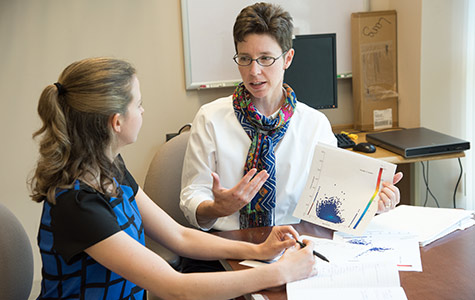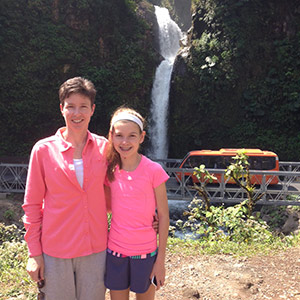
Catherine Lang doesn’t like to sit still.
She recently ran a 100-km trail relay race with four friends. This spring, she traveled across Costa Rica with her 14-year-old daughter, Meredith, while serving as a chaperone for the teen’s Spanish class. And after work and on the weekends, she volunteers for the St. Louis Blazers track club, of which her daughter is a member.
Lang’s love of movement also drives her work. As director of Washington University School of Medicine’s Neurorehabilitation Research Laboratory, she helps stroke survivors regain what their strokes took from them.
With an aim of effective and efficient individualized rehabilitation, she focuses on the upper extremities — the hands, arms and shoulders. She approaches her work with an extensive background in movement science and physical therapy. Both her graduate work and postdoctoral research involved looking at how specific areas of the brain control and contribute to upper-extremity movement.
A professor of physical therapy, of neurology and of occupational therapy, Lang, PhD, and her colleagues developed what’s referred to as the Brain Recovery Core, which coordinates the range of stroke rehabilitation services patients receive. The goal was to build an integrated system of stroke rehabilitation, from a patient’s initial treatment to his or her return to home and life in the community.
The Brain Recovery Core involves a partnership between Barnes-Jewish Hospital, The Rehabilitation Institute of St. Louis and Washington University, and it is funded by The Foundation for Barnes-Jewish Hospital. In addition to the services provided to patients, researchers also have opportunities to study stroke recovery and rehabilitation as patients move from one step of recovery to the next.
“There are very few places that have a high-quality physical therapy program that is wedded with really good — and very collaborative — neuroscience and neurology programs,” Lang said. “Our research blossoms here in ways it wouldn’t elsewhere.”
A big part of the reason it blossoms is Lang, according to Gammon M. Earhart, PhD, director of the Washington University School of Medicine Program in Physical Therapy.
“Dr. Lang is a world-class motor-systems neuroscientist and expert physical therapist who has made sustained and substantial contributions to the field of neurorehabilitation,” Earhart said. “Her multifaceted, interdisciplinary, collaborative approach to research sets her apart and uniquely positions her to generate and translate new knowledge from the laboratory to the clinic, with the ultimate goal of enhancing outcomes for people following stroke.”

The road to academia
Lang, the third of five children, was raised in Middlebury, Vt., a small, rural town.
“Vermont was the center of my world,” she said. “I used to think that Delaware was the deep South and Pennsylvania was the far West.”
Interested in exercise, movement and health, Lang enrolled in the University of Vermont’s physical therapy program. After earning her bachelor’s degree, she became a licensed physical therapist and was convinced she was done with school.
She accepted a position in a rehabilitation hospital in Portland, Maine, and enjoyed the fast pace and complexity of inpatient care in neuro-rehab. But she felt the lure of academia and went on to earn her master’s degree in physical therapy at Vermont.
She followed her love of movement to Washington University’s movement science program, where Amy Bastian, PhD (now at the Kennedy Krieger Institute in Baltimore), was her mentor. After earning a doctorate in physical therapy, Lang completed a postdoctoral fellowship in neurology at the University of Rochester under the mentorship of School of Medicine alumnus and former faculty member Marc Schieber, MD. There, she studied control of finger movements before heading back to Washington University, where she became a member of the physical therapy faculty.
Finding focus
Shortly after beginning her faculty position, Lang secured a career-development grant from the National Institutes of Health (NIH). But after she was hired, her initial idea of what she was going to do in her lab changed dramatically.
“Like every good job applicant, I had a slide at the end of my presentation to the interview committee in the Program of Physical Therapy,” she recalled. “It explained the experiments and questions that I planned to investigate — and I don’t think I’ve answered any of them. But that’s the way science works: You do an experiment to see if you’re right, and sometimes you end up being wrong. But the wrong answer can be much more interesting and even more valuable than the right answer would have been.”
Lang’s current research focus has taken a turn she hadn’t anticipated. In the 1970s and ‘80s, the accepted approach to stroke rehabilitation was one-size-fits-all. Patients received the same type of therapy, which involved strengthening muscles.
“We’ve really switched to more practical questions with our research,” Lang explained. “We’re very much interested in figuring out what types of interventions are uniquely suited for a particular individual and looking at ways we can tailor that intervention to maximize the person’s specific abilities.”
Lang stressed that her research is based on outcomes. If a patient performs well in the lab or clinic but that performance doesn’t carry over into daily life activities, then the intervention is not considered a success, she explained.
She and her team also are working on novel methods to measure movement behavior so that interventions can be gauged and success measured outside of the lab or clinic. One such method involves the use of sensors called accelerometers, which patients wear to help researchers assess their movements.
“Accelerometers have been around for a while, but we’ve developed a way to use them in a clinical environment,” Lang said. “We use an algorithm that can help determine whether a part of the body is moving or not moving. This gives us accurate records of real-world movement behavior.”
Lang’s lab is building a website that will allow others to upload and process data using these algorithms.
Sharing the science
Outside of the lab, Lang lectures on movement science and in courses focused on motor systems neuroscience, motor control, and motor learning and stroke rehabilitation. She has mentored six doctoral students and has been invited to present her research findings at regional, national and international meetings.
Last year, she began a three-year term on the American Heart Association Stroke Council’s Rehabilitation and Recovery Committee. She also is an associate editor for the Journal of Neurologic Physical Therapy.
When not working, she enjoys spending time with her husband, Larson Lang, and their daughter — preferably walking, hiking, running or doing something on the move.
And though she has been gone from her native Vermont for many years now, she, Larson and Meredith head back to her family’s cottage in New Hampshire every year. Her four siblings and their families all converge there the same week.
“It’s a classic New England cottage setting,” she said. “There are 15 people packed into a two-bedroom cottage with attic sleeping. I’m still considered a kid, so I don’t get one of the downstairs bedrooms yet. That’s for the grandparents, and we’re all aspiring to that.”